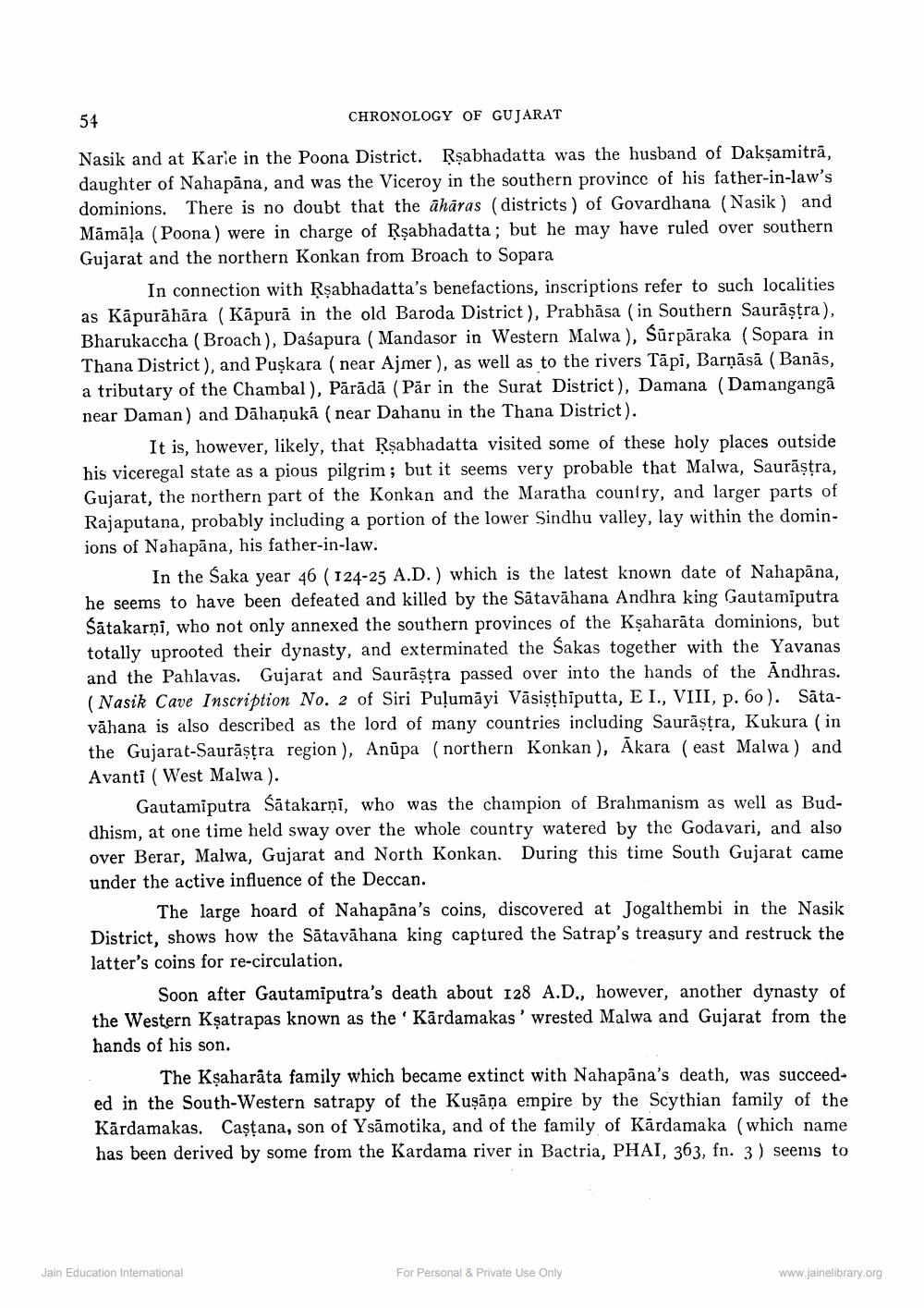________________
54
CHRONOLOGY OF GUJARAT
Nasik and at Karle in the Poona District. Rşabhadatta was the husband of Dakşamitrā, daughter of Nahapāna, and was the Viceroy in the southern province of his father-in-law's dominions. There is no doubt that the āhāras (districts) of Govardhana (Nasik ) and Māmāļa (Poona) were in charge of Rşabhadatta; but he may have ruled over southern Gujarat and the northern Konkan from Broach to Sopara
In connection with Rşabhadatta's benefactions, inscriptions refer to such localities as Kāpurāhāra ( Kāpurā in the old Baroda District), Prabhāsa (in Southern Saurāṣtra), Bharukaccha (Broach), Daśapura (Mandasor in Western Malwa ), Sürpāraka (Sopara in Thana District), and Puşkara (near Ajmer), as well as to the rivers Tāpi, Barņāsā (Banās, a tributary of the Chambal), Pārādā (Pār in the Surat District), Damana (Damangangā near Daman) and Dāhaṇukā (near Dahanu in the Thana District).
It is, however, likely, that Rşabhadatta visited some of these holy places outside his viceregal state as a pious pilgrim; but it seems very probable that Malwa, Saurāştra, Gujarat, the northern part of the Konkan and the Maratha country, and larger parts of Rajaputana, probably including a portion of the lower Sindhu valley, lay within the dominions of Nahapāna, his father-in-law.
In the Saka year 46 (124-25 A.D.) which is the latest known date of Nahapāna, he seems to have been defeated and killed by the Sātavāhana Andhra king Gautamiputra Satakarni, who not only annexed the southern provinces of the Kşaharāta dominions, but totally uprooted their dynasty, and exterminated the Śakas together with the Yavanas and the Pahlavas. Gujarat and Saurāṣtra passed over into the hands of the Andhras. (Nasik Cave Inscription No. 2 of Siri Puļumāyi Vāsişthiputta, E I., VIII, p. 60). Sātavāhana is also described as the lord of many countries including Saurāşțra, Kukura (in the Gujarat-Saurāşțra region), Anūpa (northern Konkan), Akara (east Malwa) and Avanti (West Malwa).
Gautamiputra Sātakarni, who was the champion of Brahmanism as well as Buddhism, at one time held sway over the whole country watered by the Godavari, and also over Berar, Malwa, Gujarat and North Konkan. During this time South Gujarat came under the active influence of the Deccan.
The large hoard of Nahapāna's coins, discovered at Jogalthembi in the Nasik District, shows how the Sātavāhana king captured the Satrap's treasury and restruck the latter's coins for re-circulation.
Soon after Gautamiputra's death about 128 A.D., however, another dynasty of the Western Ksatrapas known as the 'Kārdamakas' wrested Malwa and Gujarat from the hands of his son.
The Kşaharata family which became extinct with Nahapāna's death, was succeeded in the South-Western satrapy of the Kuşāņa empire by the Scythian family of the Kārdamakas. Castana, son of Ysāmotika, and of the family of Kārdamaka (which name has been derived by some from the Kardama river in Bactria, PHAI, 363, fn. 3) seems to
Jain Education Interational
For Personal & Private Use Only
www.jainelibrary.org




